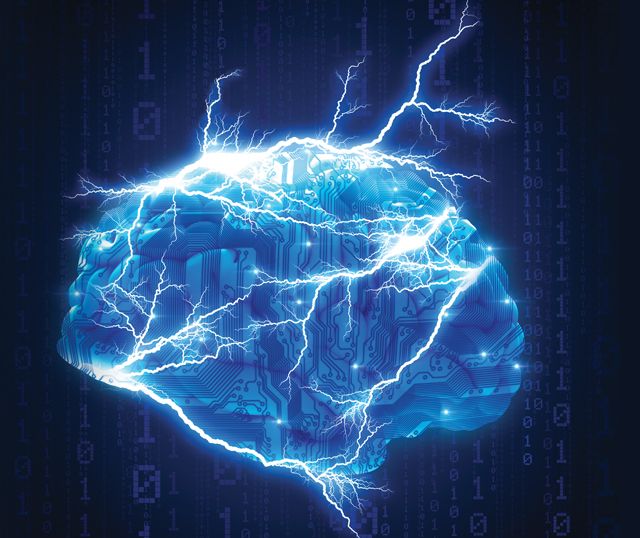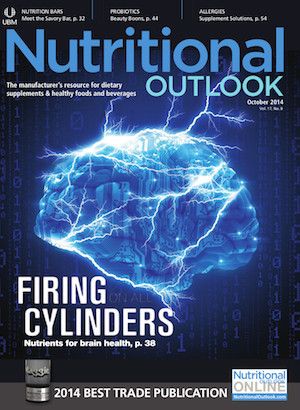Brain Health Dietary Supplement Ingredient Research Update
There’s a downpour of research on nutrients for brain health.

Purified in a lab or plucked on a farm, dietary ingredients have proven, time and again, to have profound influences on the human body. The human brain is no exception to this chemical wonder, and so scientists continue testing plants and nutrients, hoping to find ones with influence on the brain. What have they found lately? Here’s a sampling of recent findings, involving everything from herbs and flowers to vitamins and minerals.
Ginseng Milk
Milk can be a delicious delivery system for nutrients, and maybe even for ginseng. While the popular brain health ingredient isn’t normally added to milk, a recent study suggest that it can be.
When Spanish and French researchers assessed the stability and acceptability of American ginseng (Panax quinquefolius L.) extract in milk, they saw a 67.6% recovery of ginseng, even after ultra-high heat temperature (UHT) treatment. Writing in the Journal of Dairy Science, the team admitted that the bitter root didn’t impress everyone involved in an adjoining consumer taste test, but adding sucralose and vanilla extract to the milk did help mask ginseng off-notes. If a ginseng milk like this goes to market, just 150–300 ml of milk should be enough to provide the amount of ginseng recommended in many brain health studies.
Interested manufacturers, particularly in Canada, should remember that the American ginseng extract Cereboost from Naturex SA (Avignon, France) earned a Canadian health claim last year. The language options include “Helps to support cognitive function,” “Helps to support cognitive performance,” and “Helps to support working memory.”
Phosphatidylserine
Phosphatidylserine (PS) presents another peculiar milk addition because this lipid is already present in breast milk. In the case of Enzymotec Ltd. (Migdal HaEmeq, Israel), though, PS comes from soybean lecithin. A Chinese baby food manufacturer named Beingmate is convinced enough by the science on this purified PS that it’s using the ingredient in a brand new UHT milk. The legume-derived PS is suitable for milk powders, too.
PS enjoyed another victory this year, but it had nothing to do with milk. European researchers, writing in the journal Lipids in Health and Disease, performed a human clinical trial on 75 men consuming Lonza Inc.’s (Allendale, NJ) soybean PS in the form of a MemreePlus dietary supplement. When men ingested this combination of PS and phosphatidic acid in one 400-mg capsule, those with high stress experienced reductions in stress biomarkers, such as blood levels of cortisol, significantly more than placebo.
Saffron Capsules
Unsurprisingly, Iran just birthed another study on saffron, which happens to be one of its biggest cash crops. While researchers at Tehran University investigate the purple flower often, their latest study on saffron and Alzheimer’s disease is the longest performed on the flower and this disease.
For a full year, 68 Alzheimer’s patients consumed daily capsules containing saffron (30 mg) or Memantine (20 mg), a prescription drug for Alzheimer’s. Every month, participants submitted to two cognitive tests-the Severe Cognitive Impairment Rating Scale (SCIRS) and the Functional Assessment Staging Test (FAST)-to help researchers measure any cognitive decline during the study. After one year, researchers could not detect significant difference between scores of either group, suggesting that saffron stigmas may be as effective as the Alzheimer’s drug in slowing cognitive decline that is expected with Alzheimer’s.
While this study included patients with moderate-to-severe Alzheimer’s, it follows two previous saffron trials on mild-to-moderate Alzheimer’s patients. In those, saffron slowed cognitive decline better than placebo and as efficiently as a drug for treating dementia. Manufacturers can obtain saffron extract from suppliers such as Nutraceuticals International Group (Paramus, NJ).
Citicoline for Kids
Citicoline is a substance found in all human cells, and researchers already understand some of its uses, including a role in the development of phospholipids, such as those that make up brain tissue. But, while pure citicoline has been studied in adults, researchers admit they know little about citicoline use in children.
To close the gap, researchers at the University of Utah’s Brain Institute completed a trial on children supplementing with placebo or Cognizin, a branded form of citicoline from Kyowa Hakko USA (New York City). Using a Finger Tap Test and a Ruff 2 & 7 Selective Attention Test-common methods for measuring motor speed and attention, respectively, in clinical settings-researchers only saw test score improvements in the children consuming Cognizin (for 28 days).
Citicoline can be obtained naturally in the diet, but Kyowa Hakko says foods generally contain this nutrient in only small amounts. The company’s citicoline ingredient is the only such ingredient available for dietary supplement and functional food use in the United States.
African Succulent
Defying the notion that succulents are just for decorating homes, PLT Health Solutions Inc. (Morristown, NJ) is marketing Sceletium tortuosum, a South African plant turned extract for human consumption.
In a study involving brain imaging technology, international researchers discovered that when college students consumed the ingredient instead of placebo, their brains displayed reduced reaction to threats. A decrease of brain activity in the amygdala, a portion of the brain that manages stress signals, supported their conclusion. The effect appeared to occur within hours of succulent supplementation.
Researchers with PLT Health Solutions say this third-party study provides the first evidence of exactly where Sceletium tortuosum has influence over the brain. The ingredient is currently available to manufacturers under the brand name Zembrin.
One Kind of Magnesium
Even though magnesium is an essential mineral, some experts question whether commercial magnesium forms can even reach the human brain at all.
AIDP (City of Industry, CA) explores the theory in its latest white paper on Magtein, a novel magnesium-L-threonate that the company says is the only magnesium compound shown to significantly raise magnesium levels in the brain.
In a new white paper, available at www.magtein.com, manufacturers can learn about Magtein’s mechanism of action, its safety, and its proposed efficacy in enhancing learning ability and memory. Results from a clinical trial show how Magtein performs against other magnesium forms, including magnesium chloride and magnesium citrate. Another human study on Magtein is scheduled for journal publication later this year.
Tea’s Amino Acid
The umami flavor of green tea isn’t a mystery. It comes from an abundance of the amino acid L-theanine in tea leaves. Many studies suggest that consuming this nutrient, straight up or in tea, can induce a relaxing, calming sensation. A new study from Japan is the latest support for the theory.
When 20 pharmacy students at the University of Shizuoka consumed daily L-theanine or lactose placebo a week before entering pharmacy practice for the first time, students in the L-theanine group reported significantly less stress on days of practice. The self-reports were reinforced by the fact that placebo users had higher levels of salivary alpha-amylase activity, an indicator of stress, during practice. When salivary alpha-amylase activity was higher in subjects of either group, self-reports of anxiety were higher.
Beet Fiber
Researchers in Wales says their study on Beneo Inc.’s (Morris Plains, NJ) Palatinose, a low-glycemic sweetening carb from beet fiber, improves scientific understanding of how this carbohydrate and others are metabolized and then capable of impacting the brain.
When 155 subjects consumed breakfast with a drink containing 40 g of glucose, sucrose, or Palatinose (all having identical calories but decreasing glycemic loads), mood and memory scores improved as glycemic loads decreased-but only for subjects with normal, healthy glucose production. The overarching theory here is that humans with normal blood glucose levels can still perform mental tasks efficiently after a low-glycemic meal.
Ashwagandha
Ashwagandha products are not all the same. To that end, Ixoreal Biomed (Hyderabad, India) earned a “Best Botanical Ingredient” award from Functional Ingredients magazine in 2013 in part because its ashwagandha is made entirely of root.
Ixoreal Biomed director Kartikeya Baldwa says the company markets KSM-66 ashwagandha root extract just as the ingredient is described in several pharmacopeias published around the world: pure root extract.
On the other hand, some ashwagandha extracts contain material from the root and leaf. Natreon Inc. (New Brunswick, NJ) says this strategy increases its product’s concentration of glycowithanolides. Whether or not adding leaf material is the best strategy, Natreon now has a new study to show for its decision. When subjects consumed the Natreon’s Sensoril ashwagandha before a thermal air pain test, they experienced a 12.85% increase in pain resistance compared to the placebo group. Details of this study are free to read in the Research Journal of Life Sciences.
Spearmint
The spearmint plant (Mentha spicata L.) is seldom studied for brain health, so that makes Kemin Industries Inc. (Des Moines, IA) a pioneer in the field. Already financing research on other herbs such as rosemary and oregano, Kemin just commissioned third party Biofortis (Columbia, MD) to conduct a month-long study on adults and spearmint extract.
Following a month of supplementation, reesearchers found zero gastrointestinal upsets or adverse events with the extract. But they did notice improvements in various cognitive factors, such as reasoning and concentration. Tests even suggested improvements in attention and concentration after just two and four hours of spearmint supplementation. Kemin’s extract contains spearmint’s rich stores of rosmarinic acid but also a mysterious phenolic complex the company refers to as K110-42. Expect more work on spearmint and its compounds in the near future.
Vitamin E
If free radicals can damage the human brain over time, then consumption of antioxidants such as vitamin E should help slow the rate of cognitive decline in a human’s lifetime. This theory is what keeps researchers focused on vitamin E, and two new studies on vitamin E supplements suggest that these simple capsules can impart vitamin E’s benefits to the brain.
Carotech Inc. (Edison, NJ) reports that the largest-ever study on its vitamin E complex made from palm oil is now complete. The results, published in the American Heart Association’s Stroke journal, suggest that the consumption of vitamin E can effectively curb the development of white matter lesions on the brain. These damaged brain tissues are linked to increased risk of stroke and a likelihood of developing brain diseases such as Alzheimer’s disease and Parkinson’s disease, says Carotech.
Alzheimer’s disease received special attention in a recent vitamin E trial supported by DSM Nutritional Products (Parsippany, NJ). When 613 subjects with Alzheimer’s disease supplemented with alpha-tocopherol, the Alzheimer’s drug Memantine, a combination of the two, or placebo, DSM’s vitamin E form slowed cognitive decline more than placebo.
Curcumin
An active compound in the spice turmeric, curcumin is constantly a top-selling dietary supplement ingredient. The logic behind consuming turmeric and curcumin is that these ingredients can curb inflammation in the body. Interestingly enough, researchers say that depression is often associated with high levels of inflammation.
With the help of a highly standardized curcumin ingredient called BCM-95, researchers measured curcumin’s effect against placebo in a trial on 56 subjects with clinically diagnosed depressive disorder. After just four weeks of supplementation with curcumin, self-reports of depression and anxiety were significantly improved compared to placebo. But we can’t assume this necessarily takes place with all curcumin ingredients. The company behind BCM-95 says that its ingredient also includes turmeric essential oil and is specially designed for high absorption.
Photo © iStockphoto.com/Henrik5000


.png&w=3840&q=75)

.png&w=3840&q=75)



.png&w=3840&q=75)



.png&w=3840&q=75)












